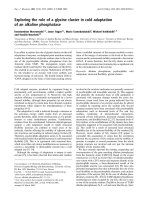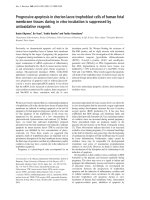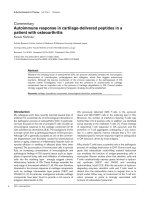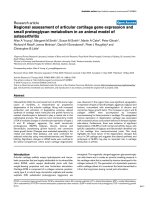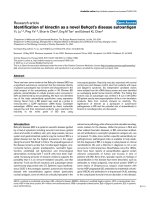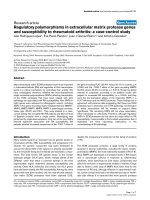Báo cáo y học: "Lipooxygenase inhibition in osteoarthritis: a potential symptomatic and disease modifying effect" ppsx
Bạn đang xem bản rút gọn của tài liệu. Xem và tải ngay bản đầy đủ của tài liệu tại đây (41.39 KB, 2 trang )
Page 1 of 2
(page number not for citation purposes)
Available online />Abstract
5-Loxin
®
is a compound extracted from an ancient herb that might
be considered as a potent lipooxygenase inhibitor. The results
observed in a preliminary trial suggest a highly intriguing clinically
relevant symptomatic effect contrasting with a poor bioavailability
of this compound. Moreover, in this trial, a statistically significant
decrease in matrix metalloproteinase enzyme serum level suggests
that, in addition to the observed symptomatic effect, such a
compound might have a disease modifying effect in osteoarthritis.
Further studies are required both to confirm the symptomatic
efficacy and acceptable safety profile and to evaluate the potential
chondromodulating effect of this compound.
In the previous issue of Arthritis Research & Therapy,
Sengupta and colleagues [1] report the results of a short-
term placebo randomized controlled trial evaluating both the
symptomatic and biological effects of the compound 5-
Loxin
®
, which is a gum resin extracted from an ancient herb.
Despite the small sample size (25 patients per arm) and the
short duration of this trial (3 months), the reported results are
interesting and intriguing for several reasons.
In the field of rheumatology, most new therapeutic com-
pounds are based on our knowledge of the patho-
physiological pathways of the disease (for example, targeted
therapies against cytokines such as tumor necrosis factor
(TNF), interleukin-6, and so on) or against some specific
enzyme (for example, cyclooxygenases). The compound
evaluated in the trial reported by Sengupta and colleagues
[1] is in fact derived from an ancient herb, Boswella. Because
of the empirically observed anti-arthritic and analgesic effects
of this compound, researchers have tried to understand its
mechanism of action. In vitro data suggest that 5-Loxin
®
might be considered as a potent lipooxygenase inhibitor but
also, at a lower magnitude, an inhibitor of the TNFα-induced
gene expression of matrix metalloproteinases. Such in vitro
findings have to be kept in mind when interpreting the results
of the trial. In particular, should we consider that the observed
symptomatic treatment effect is related to the lipooxygenase
inhibition, to the anti-TNFα inhibition, to both, or to an as yet
unknown mechanism?
This trial has been conducted in India. The researchers have
to be congratulated because of the high quality of both the
design, the conduct, the analysis and the reporting of the trial.
The observed symptomatic placebo effect is of a similar mag-
nitude as those observed in previous placebo randomized
controlled trials in this condition [2,3]. The observed sympto-
matic effect (for example, the differences in the changes in
the active minus the placebo groups) seems to be not only
statistically relevant but also highly clinically relevant. In
osteoarthritis, a symptomatic treatment effect of a least 10 on
a scale of 0 to 100 is usually considered as clinically relevant
[4]. In this reported trial, a treatment effect of 26 (for the VAS
[Visual Analogue Scale] score), 18 (for the WOMAC
[Western Ontario and MacMaster universities osteoarthritis
questionnaire] pain subscale) and 15 (for the WOMAC
function sub-scale) were observed in the group of patients
taking the compound at a 250 mg daily dose when compared
to placebo. Moreover, a trend in favor of a dose ranging effect
(when comparing placebo, 5-Loxin
®
100 mg and 5-Loxin
®
250 mg) supports the relevance of these results. These
results are intriguing since the oral bioavailability of the active
ingredient of 5-Loxin
®
is very low [5]. Such findings
concerning the symptomatic effect of this compound have
now to be confirmed in larger trials conducted in different
parts of the world.
More intriguing are the results observed for some biological
markers, especially matrix metalloproteinase-3 serum levels.
Editorial
Lipooxygenase inhibition in osteoarthritis: a potential
symptomatic and disease modifying effect?
Maxime Dougados
Paris-Descartes University, Medicine Faculty; UPRES-EA 4058; AP-HP, Cochin Hospital, Rheumatology B Department, Paris, France
Corresponding author: Maxime Dougados,
Published: 19 September 2008 Arthritis Research & Therapy 2008, 10:116 (doi:10.1186/ar2490)
This article is online at />© 2008 BioMed Central Ltd
See related research article by Sengupta et al., />TNF = tumor necrosis factor.
Page 2 of 2
(page number not for citation purposes)
Arthritis Research & Therapy Vol 10 No 5 Dougados
Such findings raise the question of whether we should
consider this compound as an alternative to the currently
available symptomatic drugs (for example, analgesics, cyclo-
oxygenase inhibitors, and so on) because of potentially better
efficacy and safety profiles, or whether we have to consider
that, in addition to its symptomatic effect, such a compound
might have an osteoarthritic disease modifying effect. The
demonstration of a disease modifying effect requires long-
term studies with hard end-points, such as the capacity to
reduce the requirement for total articular replacement, to
reduce cartilage loss, and so on. In this study, the researchers
have evaluated an interesting surrogate biomarker in this area,
for example, the level of matrix metalloproteinase-3, which is
deeply involved in the degradation of cartilage [6].
In conclusion, because of obvious unmet needs in the
treatment of osteoarthritis and because we have yet to
develop an efficient and safe targeted therapy, the reported
results observed with this new compound are very promising,
although they need to be confirmed in other studies
evaluating not only its symptomatic effect but also its
potential chondromodulating effect.
Competing interests
The author declares that they have no competing interests.
References
1. Sengupta K, Alluri KV, Sathis AR, Mishra S, Golakoti T, Sarma
KVS, Dey D, SP Raychaudhuri: A double blind, randomized,
placebo controlled study of the efficacy and safety of 5-
Loxin
®
for treatment of osteoarthritis of the knee. Arthritis Res
Ther 2008, 10:R85.
2. Dougados M, Leclaire P, van der Heijde D, loch DA, Bellamy N,
Altman RD: Response criteria for clinical trials on osteoarthri-
tis of the knee and hip: a report of the OsteoArthritis
Research Society International Standing Committee for Clini-
cal Trials response criteria initiative. Osteoarthritis Cartilage
2000, 8:395-403.
3. Pham T, van der Heijde D, Altman RD, Anderson JJ, Bellamy N,
Hochberg M, Strand V, Woodworth T, Dougados M: OMERACT-
OARSI initiative: Osteoarthritis Research Society International
set of responder criteria for osteoarthritis clinical trials revis-
ited. Osteoarthritis Cartilage 2004, 12:389-399.
4. Dougados M, Moore A, Yu S, Gitton X: Evaluation of the patient
acceptable symptom state in a pooled analysis of two multi-
centre, randomized, double-blind, placebo-controlled studies
evaluating lumiracoxib and celecoxib in patients with
osteoarthritis. Arthritis Res Ther 2007, 9:R11.
5. Buchele B, Zugmaier W, Genze F, Simmet TJ: High-perfor-
mance liquid chromatographic determination of acetyl-11-
alpha-boswellic acid, a novel pentacyclic triterpenoid, in
plasma using a fluorinated stationary phase and photodiode
array detection: application in pharmacokinetic studies. Chro-
matogr B Analyt Technol Biomed Life Sci 2005, 289:144-148
6. Pelletier JP, Martel-Pelletier J : DMOAD developments: present
and future. Bull NYU Hosp Jt Dis 2007, 65:242-248.

